For 2017, Yamaha has continued to push the envelope as the leading Japanese manufacturer to offer a variety of closed-course competition off-road motorcycles. Their line up includes the YZ250X (two-stroke), YZ250FX, and YZ450FX; all of which are considered by Yamaha to be GNCC/woods-ready racers, based off of their flagship motocross models. For our initial impressions of these models, the Dirt Rider crew headed out to our testing grounds in order to learn more about what the Yamaha YZ-X motorcycles have to offer.
Keeping up with its off-road counterparts, this two-stroke motorcycle comes standard with an 18” rear wheel, integrated kickstand, and cross-country suspension settings. The only change for 2017 is a new 270mm front brake and brake pad material aimed at more stopping power and feel up front.
This motor shines in multiple areas, but what stands out the most is the mid-to-top end portion of the power band. The 250X powerplant loves to stay in this zone, ready to attack at the flick of the clutch. It boasts a lot of useable power on the trail, and when given the chance to open up, will impress any high-speed fanatic. On the other hand, the bottom-end does lack a little in the torque department. It does not have the low-end power to crawl and chug like one of its 300cc off-road competitors. That being said, for a 250 two-stroke, the powerband is widened, especially compared to the YZ250 (mx model). This bike stays true to the two-stroke fan base, as its raw unaltered power band makes the bike a blast to ride.
Cross-country tuned KYB components grace the 250X as well. Due the naturally lighter weight of this machine, the overall feel of the suspension on this bike was determined to be the winner out of our test riders, as they felt it had the most plush, stable feel of the bunch. The action of the fork was subtle but progressive, keeping up in both low and high-speed sections. The shock felt the same way, providing ample traction when needed and great bottoming resistance in deep whoops. In general, the 250X has a very well balanced feel from front to rear, allowing the fork and shock to work in unison.
Thin, lightweight, and nimble are all features that make this chassis a stand out and our test riders agreed that it does not take long to get comfortable on this machine. Cornering is made easy in either the standing or sitting position when riding the 250X, and the bike will react quickly when you tell it where to go. It has plenty of front-end bite and the rear-end will follow suit no matter which direction you are pointed. On the other hand, when trying to keep up with the progression of the industry in 2017, a few flaws come to mind. All of our test riders agreed that the 250X communicated some pretty harsh vibrations through the handlebar and foot pegs. Furthermore, the lack of “the magic button” (electric start) becomes that much more obvious after riding several other off-road two strokes back to back in the same day.
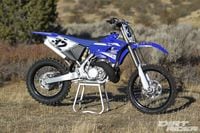
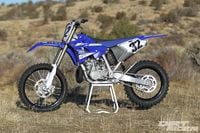
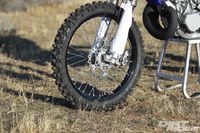
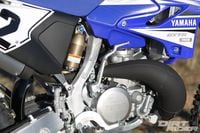
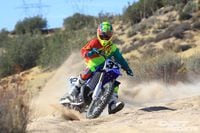
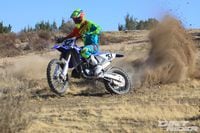
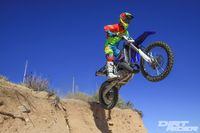
/cloudfront-us-east-1.images.arcpublishing.com/octane/SQ3CEIVCOJF7FDERDVDKKPIC7A.jpg)
/cloudfront-us-east-1.images.arcpublishing.com/octane/LLLQLRK2DBH4PN66MDNA3AFJNY.jpg)
/cloudfront-us-east-1.images.arcpublishing.com/octane/5DMU4K752FBWLLJD432GRAAH2A.jpg)
/cloudfront-us-east-1.images.arcpublishing.com/octane/TGHDVMIODJC4BNKJDZKKTSWXWI.jpg)
/cloudfront-us-east-1.images.arcpublishing.com/octane/5KYMT24REJEFPNO2J2M76MXERM.jpg)
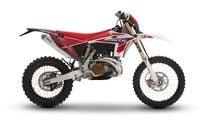
/cloudfront-us-east-1.images.arcpublishing.com/octane/3GXGR3EKSNH5NI3CWHV5SJ7TXE.jpg)
/cloudfront-us-east-1.images.arcpublishing.com/octane/JEU3ONDWEFCAZNAZJOU24OJ2PM.jpg)
/cloudfront-us-east-1.images.arcpublishing.com/octane/JQ6LMK6LLBAQJIL2AH56UIUKWU.jpg)
/cloudfront-us-east-1.images.arcpublishing.com/octane/QUSF4LLRM5DDPCJW25RINQRJPE.jpg)
/cloudfront-us-east-1.images.arcpublishing.com/octane/FYDGK7GF4JBPXERA5RAZPY3YJI.jpg)
/cloudfront-us-east-1.images.arcpublishing.com/octane/JE7KMNASNRGR7FLYAFRZAR7T7E.jpg)
/cloudfront-us-east-1.images.arcpublishing.com/octane/7RCNKJJNXBF4LBKZXE2INNWZUY.jpg)
/cloudfront-us-east-1.images.arcpublishing.com/octane/BAGM5E4EWBHFNLZOXMSLOLKQGU.jpg)
/cloudfront-us-east-1.images.arcpublishing.com/octane/RSX65VBXY5FRLIY4LN6WLOKAFM.jpg)
/cloudfront-us-east-1.images.arcpublishing.com/octane/3EO2CNKWUFBGNMGNJPETW5HCNY.jpg)
/cloudfront-us-east-1.images.arcpublishing.com/octane/IYHM55XRNVHF3DSS3467PZ7ONQ.jpg)
/cloudfront-us-east-1.images.arcpublishing.com/octane/L7K3FIINEBHMZI2TXTUE4FXH7I.jpg)
/cloudfront-us-east-1.images.arcpublishing.com/octane/XE7P5YXNZZDUTIGW4YNWQRDVY4.jpg)
/cloudfront-us-east-1.images.arcpublishing.com/octane/AV55DOHQ3BEXJLPWR6UWLYUSAQ.jpg)
/cloudfront-us-east-1.images.arcpublishing.com/octane/MMROGOYHXZAYDC4RKIDJ4VRSGA.jpg)
/cloudfront-us-east-1.images.arcpublishing.com/octane/FHRWLPEOTBFOHFTQLIHJNIXCFQ.jpg)
/cloudfront-us-east-1.images.arcpublishing.com/octane/J2RUDOXTOZHBXOFCUQKBAGBMAQ.jpg)
/cloudfront-us-east-1.images.arcpublishing.com/octane/UDQASRGJ3ZDG3BANXWU6P5NIQY.jpg)